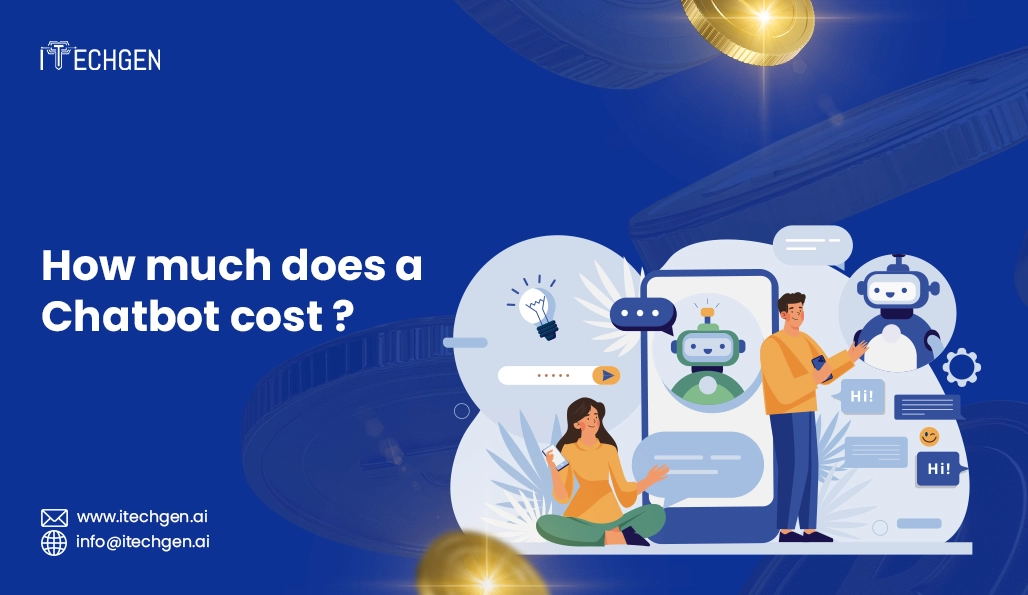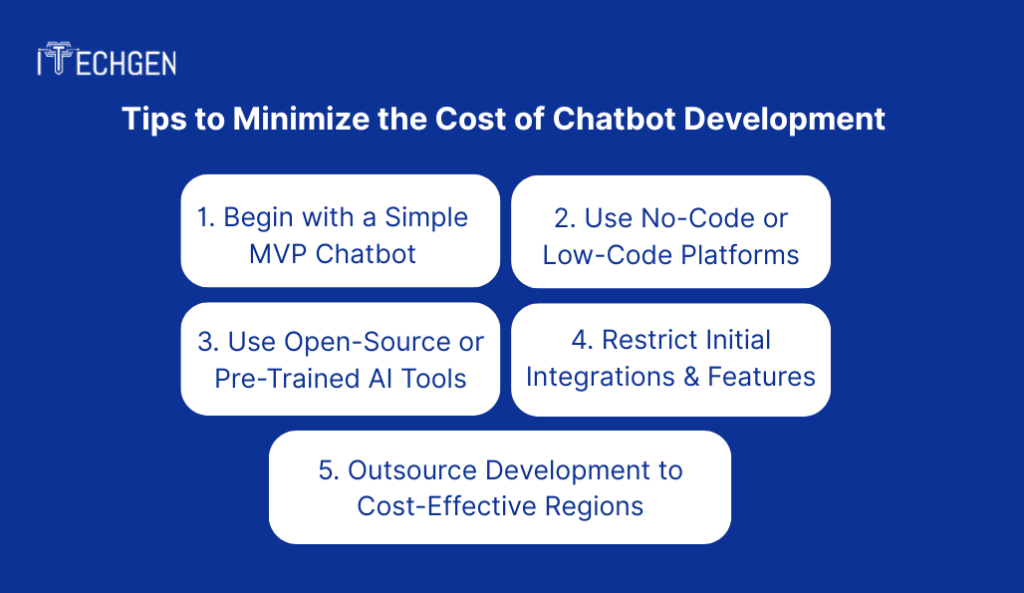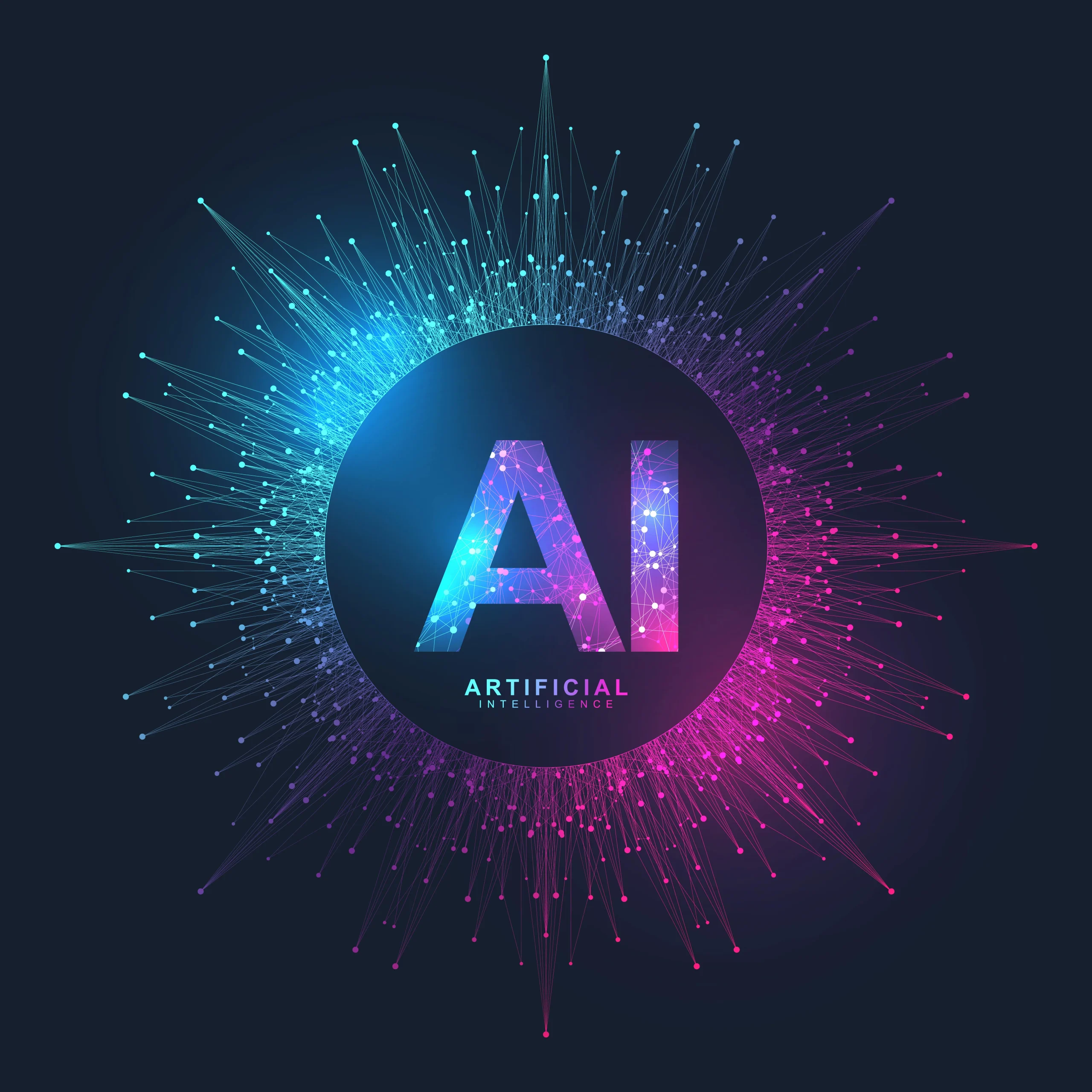How much does a Chatbot cost?

As more businesses are adopting automation and 24/7 support, chatbots are becoming a necessity rather than a luxury. Whether you’re a startup wanting to streamline their support or an enterprise that wants to scale conversations, understanding the cost of a chatbot is key to your investment. Robot pricing is not easy; it is contingent upon the performance of the bot, AI capabilities, building a bot, using a chatbot platform, and how it integrates with other systems. In this guide we will outline the true cost of building and maintaining a chatbot in 2025, from simple conversational bots to more complex AI-driven virtual assistants. By the end of this guide, you will know what to expect and how to budget for your chatbot project.
How Much Does a Chatbot Cost?
According to industry surveys, the cost of building a chatbot may go from as low as $5,000 to well over $150,000, depending upon factors such as complexity, technology stack, use case, or engagement model (i.e., do-it-yourself platforms versus custom builds). It is generally stated that rule-based bots are less costly, while AI-enabled bots that use NLP and third-party integrations tend to come in the higher price category.
The following are some of the components to consider in assessing where your chatbot budget may be:
Chatbot Development Cost Estimation Table
| Stage | Description | Estimated Cost (USD) |
| Discovery & Planning | Research, use case definition, scope documentation | $500 – $5,000 |
| UI/UX Design | Chatbot persona design, conversation flows, interface mockups | $1,000 – $8,000 |
| Core Development | Frontend and backend development, chatbot engine setup | $4,000 – $40,000 |
| NLP & AI Integration | Natural Language Processing, Machine Learning, training datasets | $5,000 – $50,000+ |
| Third-Party Integrations | CRM, payment gateway, ERP, social media, or custom APIs | $2,000 – $15,000 |
| Testing & QA | Functionality, compatibility, and performance testing | $1,000 – $5,000 |
| Deployment | Cloud setup, chatbot hosting, and deployment to platforms (e.g., web, WhatsApp) | $500 – $3,000 |
| Maintenance & Support | Ongoing updates, bug fixes, training data enhancement | $100 – $2,000/month |
Total Estimated Cost: $5,000 to $150,000+
(Basic bots may cost under $10,000, while enterprise-grade AI bots with custom features can exceed $100,000.)
Types of Chatbots and Their Impact on Cost

One of the strongest determiners of price would be the type of chatbot. Every chatbot carries with it an extra cost based on the complexity of the chatbot itself, its capabilities, and the supporting technology. The different types of chatbots are identified below, starting from basic rule-based bots up to complete AI-based bots:
1. Simple Chatbots (Rule-based)
Description:
These are the simplest forms of chatbots. They operate on predetermined rules and decision trees, giving responses based on certain keywords or patterns of the user’s input. Rule-based chatbots can only reply to user input with predetermined answers and have no ability to learn or go beyond programmed rules.
Platform Examples:
- Botpress: An open-source platform specifically intended for rule-based and conversational AI chatbots to be built and run by developers in modular architecture. It has easy integration with visual flow builders as well as messaging platforms.
- ManyChat: An easy-to-use chatbot builder generally designed for Facebook Messenger, Instagram, and WhatsApp. It offers an avenue for companies to automate marketing, sales, and support via visual workflows without needing to understand how to code.
- Tars: Tars is a no-code chatbot builder with a lead generation and customer support focus. It allows companies to create conversion-driven bots by dragging and dropping targeting landing pages and websites.
Cost Impact:
Rule-based simple bots tend to be the cheapest to build. They can be developed on bot-building platforms such as Botpress or ManyChat, with fees ranging from $100 per month and up, depending on use. Pricing is usually tiered by token use, database space, number of users, and feature availability.
Ideal For:
- FAQ bots
- Lead generation
- Appointment scheduling
2. Interactive Chatbots (Platform-based)
Description:
These are more advanced than rule-based bots, having an element of interaction beyond scripting. They permit some natural language processing (NLP), which helps the bot respond to and comprehend variations in how questions can be asked. Solutions such as Intercom, Drift, or Zendesk support users to develop these chatbots with little coding knowledge.
Platform Examples:
- Intercom: A traditional customer communication platform to onboard customers (using chatbots and live chat), automate support, and provide customer service with help desk tools.
- Drift: A conversational marketing platform utilizing chatbots to assist companies with lead qualification, scheduling meetings, and chatting with website visitors. It prioritizes real-time chat and is integrated with CRMs and marketing automation platforms.
- Zendesk: An all-around customer service software with chatbots based on AI to manage typical questions, support ticket triage, and direct users to human support agents when necessary. It’s really good in support and helpdesk automation.
Cost Impact:
Although still quite easy to implement, interactive bots are more customized and integrated; hence, the cost is higher. Such bots range between $3,000 and $15,000 based on functionality level, integrations, and NLP support.
Ideal For:
- Customer service automation
- Sales support
- Product recommendations
3. AI-Powered Chatbots (Custom-built)
Description:
AI chatbots replicate human conversation and are used to personalize intelligent interaction between the bot and the user. They use machine learning (ML), Natural Language Processing (NLP), and complex algorithms to understand user questions, analyze past user info, and provide users with relevant responses. They can switch between different conversation patterns and improve time, depending upon access to different data.
Custom-Built Solutions:
These robots are usually customized to the needs of a particular business and are developed specifically using tools such as Dialogflow, Rasa, or custom development. They can be integrated with CRMs, ERP systems, and other third-party APIs to give a smooth user experience.
Cost Impact:
AI-powered chatbots are the costliest to create because of the technology’s intricacy. They cost between $10,000 and $50,000 for simple AI-powered bots and upwards of $100,000 for sophisticated, enterprise-level solutions with custom integrations and deep learning.
Ideal For:
- Complex customer interactions (e.g., troubleshooting, personal assistance)
- Data-driven personalization
- Virtual assistants (e.g., Siri, Alexa)
4. RPA (Robotic Process Automation) Chatbots
Description:
RPA-driven bots make tedious rule-based decision-making jobs that humans tend to do automatic. RPA bots can accomplish much with their robotic process automation, such as repetitive, routine human tasks like data entry, report creation, and form submission. They can perform repetitively mundane human tasks well; they don’t have the ability to converse with users like AI bots.
Platform Examples:
- UiPath
- Automation Anywhere
- Blue Prism
Cost Impact:
Robotic Process Automation (RPA) bots’ pricing varies based on the complexity of the processes they are automating. For example, if the automated process is relatively simple, you’ll probably spend between $5,000 and $20,000. If the process is complex, you can expect to spend even more.
Ideal For:
- Streamlining internal processes
- Automating data-intensive tasks
- Enhancing operational efficiency
5. Hybrid Chatbots (Combination of Rule-based + AI)
Description:
Hybrid bots are a mix of rules-based bots and have all of the features and reliability of AI triggers and learning capabilities. They do common task automation of rules-based bots to interact with AI features. Hybrid bots provide organizations value while scaling costs effectively.
Cost Impact:
Hybrid bots are cost-effective, costing $7,000 to $30,000, depending on the complexity of the bot and how much AI is integrated. Hybrid bots have less cost than AI-based bot solutions but provide more features to organizations looking for a little of both.
Ideal For:
- Companies that want a blend of cost savings and AI advantages
- Customer service bots with occasional sophisticated requests
- Companies with expanding automation requirements
Factors Affecting the Cost of a Chatbot
The cost of a chatbot can range widely based on various important factors. Ranging from the complexity of the chatbot to the platforms it is integrated with, every factor influences the final price. Some of the major factors impacting AI chatbot development cost are discussed below along with explanations and supporting statistics.
1. Type and Complexity of the Chatbot
As discussed above, chatbot types vary from basic rule-based bots to advanced AI-fueled solutions. The more advanced a chatbot is, the greater the development cost.
| Chatbot Type | Approximate Cost Range (USD) | Examples |
| Rule-Based Bot | $1,000 – $5,000 | FAQ bots, Lead forms |
| Interactive Bot | $3,000 – $15,000 | Sales support, onboarding bots |
| AI-Powered Chatbot | $10,000 – $50,000+ | Virtual assistants, NLP-driven bots |
| RPA-Based Bot | $5,000 – $20,000+ | Task automation bots |
| Hybrid Chatbot | $7,000 – $30,000 | Customer service with AI escalation |
2. Platform Used for Development
The cost also depends on the development platform. DIY chatbot developers are more affordable, but custom development on sophisticated platforms adds to the cost.
| Platform Type | Typical Cost Impact |
| DIY Platforms (e.g., Botpress, Tars) | Low – Basic monthly fee or freemium |
| Platform Bots (e.g., Intercom, Drift) | Medium – Subscription + integrations |
| Custom Built (e.g., Dialogflow, Rasa) | High – Developer hours + custom coding |
3. Integration Requirements
Chatbots frequently must integrate with CRMs, eCommerce platforms, databases, and other internal applications. The more integrations needed, the greater the development time and expense.
| Integration Type | Impact on Cost |
| None or minimal (email/slack) | Low |
| CRM (e.g., HubSpot, Salesforce) | Medium |
| ERP/Custom APIs | High |
Note: Complicated API integrations or secure data sync with multiple third-party applications can add $2,000–$10,000+ to your overall budget.
4. AI & NLP Capabilities
Natural Language Processing (NLP) enables bots to read human language. More sophisticated NLP and AI learning (such as GPT-based models) need more training data, setup, and testing, thus incurring a higher cost.
- Simple NLP (Pre-trained models such as Dialogflow): Lower cost, quicker setup
- Custom NLP (Training on sector-specific data): More expensive due to model training and tuning
5. User Interface (UI) & Design
The interface design of the chatbot—particularly if it’s embedded in mobile apps or bespoke web portals—contributes to the cost of development.
| Design Element | Cost Influence |
| Standard text-only chatbot | Low |
| Custom-branded chatbot UI | Medium |
| Animated/voice/chat widgets | High |
6. Development Team Location
The location of your development team has a big impact on the hourly rate. But the nature of the chatbot you’re going to create—rule-based, platform-based, or AI-powered with NLP and integrations—has a significant impact on the total price as well. More sophisticated bots demand experienced developers, data scientists, and AI engineers, thus raising the price irrespective of geography.
| Region | Hourly Rate (Mid-Level) | Senior-Level |
| India | $15 – $30/hr | $30 – $40/hr |
| Eastern Europe | $25 – $50/hr | $50 – $75/hr |
| North America | $60 – $100/hr | $100+/hr |
Choosing an offshore or nearshore development team can reduce chatbot costs while maintaining quality, but remember that building a simple rule-based bot will cost significantly less than developing an AI-powered chatbot with advanced features like NLP, machine learning, or third-party integrations.
7. Maintenance and Updates
Once the chatbot is live, you’ll need to budget for regular updates, error handling, and possibly retraining of AI models.
| Maintenance Needs | Cost |
| Minor bug fixes & updates | $100 – $500/month |
| AI training + feature updates | $500 – $2,000/month |
8. Security & Compliance
If your chatbot is working with sensitive information (such as in finance, healthcare, or law), supporting GDPR, HIPAA, or PCI compliance will add to development cost.
- Basic Security: Committed to the majority of platforms
- Advanced Security & Compliance: Can incur an additional $2,000 – $10,000+ based on audits and protocols
Tips to Minimize the Cost of Chatbot Development

Creating a chatbot need not break the bank. With the right strategic approach, you can create a robust and effective bot without burning a hole in your pocket. Here are five actionable tips to minimize your chatbot development expenses:
1. Begin with a Simple MVP Chatbot
Rather than betting everything on sophisticated AI and deep integrations, start small with a minimum viable product (MVP) that solves just your primary use case—e.g., dealing with FAQs, lead capture, or appointment booking. This gets you feedback on the chatbot’s performance and user interaction before you spend more on sophisticated features or AI technology.
2. Use No-Code or Low-Code Platforms
If your requirements are relatively straightforward, tools like Chatfuel, Landbot, or Botpress can help you build a chatbot without hiring a full development team. These platforms offer pre-built templates and intuitive visual interfaces, significantly reducing both development time and cost. This is ideal for businesses that want quick deployment and low upfront investment.
3. Use Open-Source or Pre-Trained AI Tools
Rather than creating natural language understanding (NLU) from scratch, leverage current open-source alternatives like Rasa or cloud services like Dialogflow and Microsoft LUIS. These will have pre-trained language models incorporated and capabilities with which you’ll be saving time when training AI and reduce the need for a specialist machine learning staff.
4. Restrict Initial Integrations and Features
One of the biggest drivers of cost for chatbots is adding too many third-party integrations or extra features (like voice support or payment gateways) too soon. Only do the most important integrations first—such as integrating with your CRM or ticketing system. You can add more later as you see how people are using it and receive feedback.
5. Outsource Development to Cost-Effective Regions
Buying chatbot developers in offshoring countries such as India, Vietnam, or the Philippines cuts expenses by huge amounts as compared to U.S. or European levels. For example, Indian mid-level developers usually quote $15–$30/hour and senior developers quote $30–$40/hour. Choose vendors that have proven track records in creating chatbots and transparent communication protocols.
Conclusion
Understanding the chatbot cost is essential before diving into development. While prices can range from a few hundred dollars for basic bots to several thousand for advanced AI-powered systems, the final cost depends on factors like chatbot type, required features, integrations, and the development approach. Whether you choose a no-code builder or go for a fully custom solution, keeping a clear scope and budget in mind will help avoid overspending.
By starting with a simple version, leveraging pre-built tools, and considering cost-effective development regions, businesses can deploy efficient chatbots without breaking the bank. Ultimately, the right investment in chatbot technology can lead to better customer engagement, 24/7 support, and streamlined operations—making it a worthwhile addition to any digital strategy.

Pankaj Arora (Founder & CEO)
Pankaj Arora is the Founder & CEO of iTechGen, a visionary leader with a deep passion for AI and technology. With extensive industry experience, he shares expert insights through his blogs, helping businesses harness the power of AI to drive innovation and success. Committed to delivering customer-first solutions, Pankaj emphasizes quality and real-world impact in all his endeavors. When not leading iTechGen, he explores emerging technologies and inspires others with his thought leadership. Follow his blogs for actionable strategies to accelerate your digital transformation and business growth.
View More About Pankaj Arora
